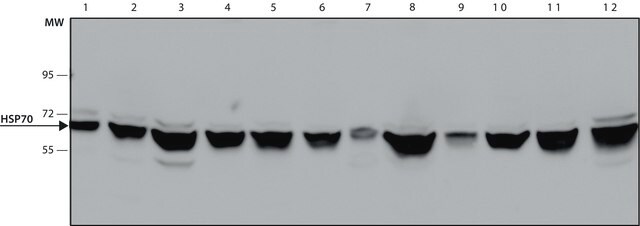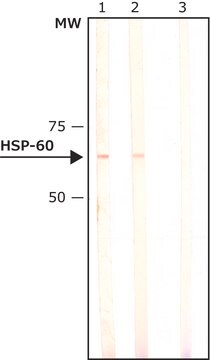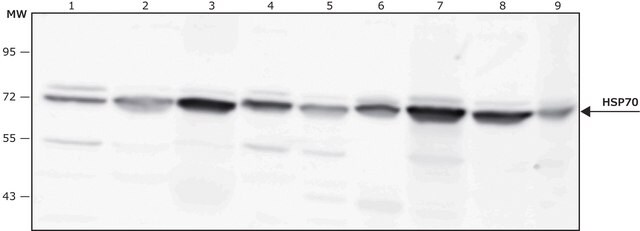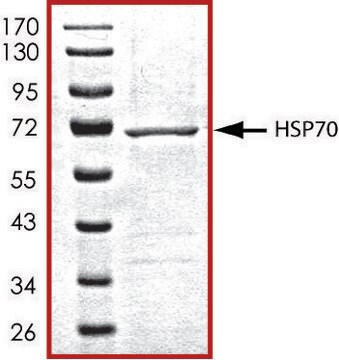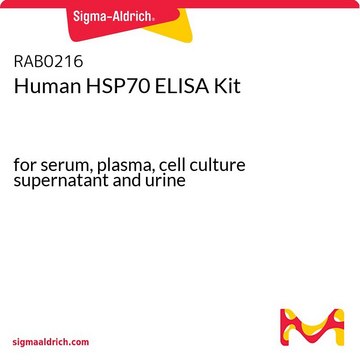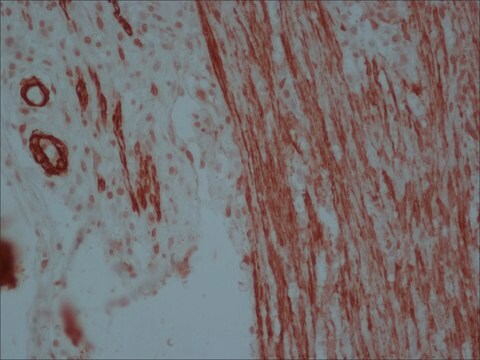H5147
Monoclonal Anti-Heat Shock Protein 70 antibody produced in mouse
clone BRM-22, ascites fluid
Synonim(y):
Przeciwciało HSP70 - monoklonalne przeciwciało przeciwko białku szoku cieplnego 70 wytwarzane u myszy, Przeciwciało Hsp70
About This Item
Polecane produkty
pochodzenie biologiczne
mouse
białko sprzężone
unconjugated
forma przeciwciała
ascites fluid
rodzaj przeciwciała
primary antibodies
klon
BRM-22, monoclonal
masa cząsteczkowa
antigen 70 kDa
reaktywność gatunkowa
bovine, chicken, guinea pig, plant, Drosophila, rat, human, nematode, rabbit, hamster
metody
electron microscopy: suitable
immunohistochemistry (frozen sections): suitable
indirect ELISA: suitable
microarray: suitable
western blot: 1:5,000 using bovine brain extract
izotyp
IgG1
numer dostępu UniProt
Warunki transportu
dry ice
temp. przechowywania
−20°C
docelowa modyfikacja potranslacyjna
unmodified
informacje o genach
human ... HSPA1A(3303) , HSPA1B(3304)
rat ... Hspa1a(24472) , Hspa1b(294254)
Opis ogólny
Specyficzność
Immunogen
Zastosowanie
Immunoprecipitation (1 paper)
Western Blotting (4 papers)
- enzyme-linked immunosorbent assay (ELISA)
- immunoblot
- dot blot
- immunocytochemistry
Działania biochem./fizjol.
Inne uwagi
SAB4200714 Anti-Heat Shock Protein 70 (HSP70) antibody, Mouse monoclonal
clone BRM-22, purified from hybridoma cell culture
Oświadczenie o zrzeczeniu się odpowiedzialności
Nie możesz znaleźć właściwego produktu?
Wypróbuj nasz Narzędzie selektora produktów.
polecane
produkt powiązany
Kod klasy składowania
10 - Combustible liquids
Klasa zagrożenia wodnego (WGK)
WGK 2
Temperatura zapłonu (°F)
Not applicable
Temperatura zapłonu (°C)
Not applicable
Wybierz jedną z najnowszych wersji:
Masz już ten produkt?
Dokumenty związane z niedawno zakupionymi produktami zostały zamieszczone w Bibliotece dokumentów.
Klienci oglądali również te produkty
Nasz zespół naukowców ma doświadczenie we wszystkich obszarach badań, w tym w naukach przyrodniczych, materiałoznawstwie, syntezie chemicznej, chromatografii, analityce i wielu innych dziedzinach.
Skontaktuj się z zespołem ds. pomocy technicznej